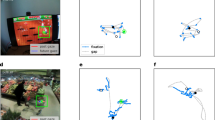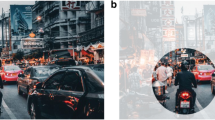Abstract
We investigate the stability limits of linear stochastic human controller model. In our previous study, we had proposed a model by which the probability distributions of human visuomotor tracking data can be accurately reproduced. In this study, we conduct a stochastic analysis on our model by deriving a system of moment differential equations with respect to random state variables of this model. We evaluate the stability limits of our model by detecting zero-eigenvalue conditions of the Jacobian matrix of the moment differential equations. The resulting stability limits make it possible to characterize the human parameter values that were experimentally identified from the human participants in our previous study; this shows that during the visuomotor tracking experiments, the human participants generated huge fluctuations far from the stability limits while applying almost neutrally stable proportional gain.




Similar content being viewed by others
References
Bottaro A, Casadio M, Morasso PG, Sanguineti V (2005) Body sway during quiet standing: is it the residual chattering of an intermittent stabilization process? Hum Mov Sci 24:588–615
Bottaro A, Yasutake Y, Nomura T, Casadio M, Morasso PG (2008) Bounded stability of the quiet standing posture: an intermittent control model. Hum Mov Sci 27:473–495
Gawthrop P, Loram I, Lakie M, Gollee H (2011) Intermittent control: a computational theory of human control. Biol Cybern 104:31–51
Gawthrop P, Lee K, Halaki M, O’Dwyer N (2013) Human stick balancing: an intermittent control explanation. Biol Cybern 107:637–652
Tnaniguchi S, Nomura T (2006) An anticipatory and low-gain neural-feedback control strategy acquired during motor learning of a balance task. IEICE Tech Rep NC 105(659):37–42 (In Japanese)
Yasutake Y, Nakamura T, Nomura T (2006) Intermittent neural intervention during human quiet stance. IEICE Tech Rep 106(330):17–20 (ME and bio cybernetics)
Cabrera JL, Milton JG (2002) On–off intermittency in a human balancing task. Phys Rev Lett 89(15):158702
Cabrera JL, Milton JG (2004) Human stick balancing: tuning Lèvy flights to improve balance control. Chaos 14(3):691–698
Suzuki S, Harashima F, Furuta K (2010) Human control law and brain activity of voluntary motion by utilizing a balancing task with an inverted pendulum. Adv Hum Comput Interact 2010:215825
Ushida S, Fukuda K, Lee J, Deguchi K (2007) Bio-mimetic control of inverted pendulum systems with time-delay. Trans Inst Syst Control Inf Eng 20(4):160–166 (In Japanese)
Ushida S (2011) Control performance improvements due to fluctuations in dynamics of stochastic control systems. In: 2011 50th IEEE conference on decision and control and European control conference, pp 1430–1436
Bormann R, Cabrera JL, Milton JG, Eurich CW (2004) Visuomotor tracking on a computer screen—an experimental paradigm to study the dynamics of motor control. Neurocomputing 58(60):517–523
Loram I, Lakie M, Gawthrop P (2009) Visual control of stable and unstable loads: what is the feedback delay and extent of linear time-invariant control? J Physiol 587(6):1343–1365
Matsumoto S, Yoshida K (2015) Parametric identification of stochastic dynamic model of human visuomotor tracking control. In: Proceedings of 2015 IEEE/SICE international symposium on system integration, pp 564–568
Aote SS, Raghuwanshi MM, Marik L (2013) A brief review on particle swarm optimization: limitations & future directions. IJCSE 2(5):196–200
Kennedy J, Eberhart R (1995) Particle swarm optimization. In: Proceedings of the international conference on neural networks, pp 1942–1948
Harada H, Mori T, Sato T (2005) Human posture probability density estimation based on actual motion measurement and eigenpostures. J Robot Mechatron 17(6):664–671
Matsumoto S, Yoshida K, Higeta A (2013) An experimental study on coupled balancing tasks between human subjects and artificial controllers. Trans ISCIE 26(11):407–414
Knodler MA Jr, Noyce DA (2005) Tracking driver eye movements at permissive left-turns. In: Proceedings of the third international driving symposium on human factors in driver assessment, training and vehicle design, pp 134–142
Gunzelmann G, Moore GRL, Salvucci DD, Gluck KA (2009) Fluctuations in alertness and sustained attention: prediction driver performance. In: Proceedings of the ninth international conference of cognitive modeling, pp 44–49
Gardiner CW (1985) Handbook of stochastic methods for physics, chemistry and the natural sciences, 2nd edn. Springer, Berlin
Nakao H (1998) Asymptotic power law of moments in a random multiplicative process with weak additive noise. Phys Rev 58(2):1591–1600
Author information
Authors and Affiliations
Corresponding author
About this article
Cite this article
Matsumoto, S., Maruya, M. & Yoshida, K. Moment stability analysis of linear stochastic human controller model in visuomotor tracking task. Artif Life Robotics 23, 34–40 (2018). https://doi.org/10.1007/s10015-017-0405-y
Received:
Accepted:
Published:
Issue Date:
DOI: https://doi.org/10.1007/s10015-017-0405-y




